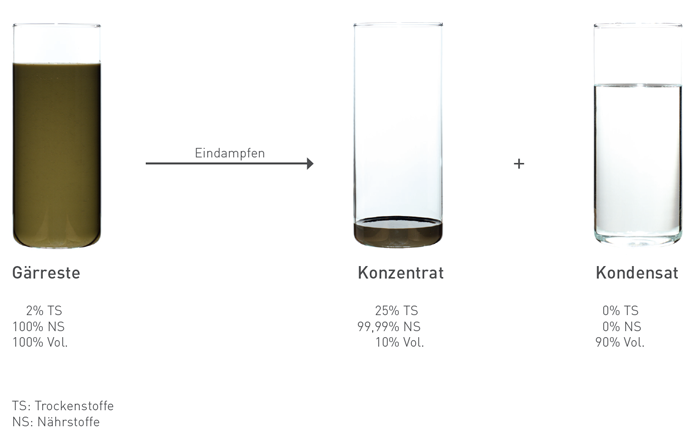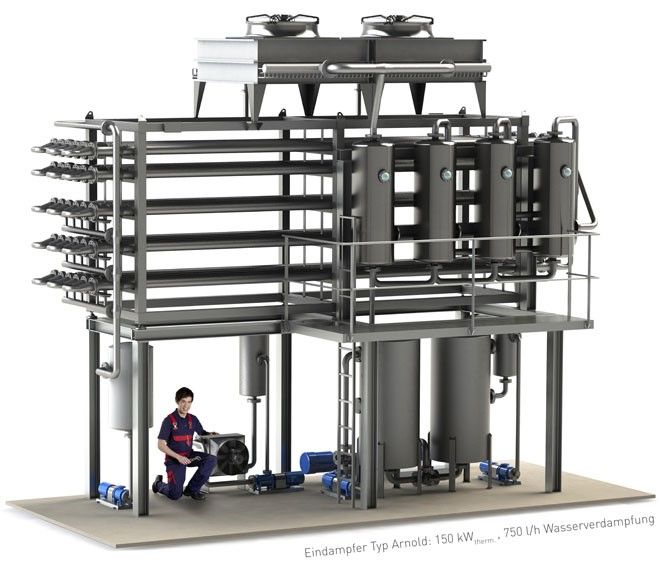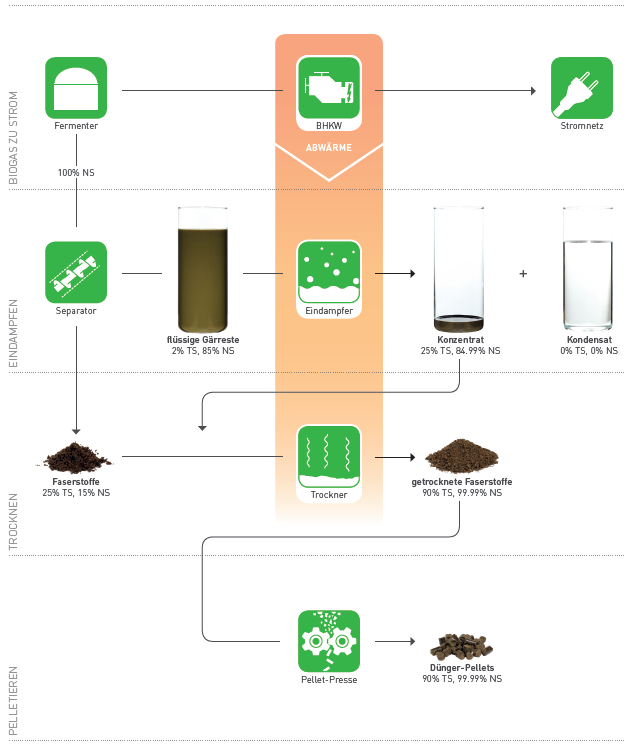Arnold Evporator
Low-temperature process with use of waste heat and complete recovery of all nutrients
Excess nutrients, storage and transport problems as well as unused waste heat are common concerns of many biogas plant operators and their residents. The problem can be alleviated by dewatering the fermentation residues. The aim is to remove as many nutrients as possible. Known separation processes such as separation, filtration or drying of the fibrous materials have little effect or are too expensive in operation.
The thermal evaporation of pumpable fermentation residues offers an optimum solution for this. It combines the unused waste products from the biogas-to-stream process and achieves two valuable end products without unwanted by-products.

Vacuum operation enables the removal of low-temperature waste heat and guarantees no odour emissions at the same time. The maximum separation efficiency and purity of the end products are guaranteed without additional process steps. On the one hand the concentrate with up to 30% dry substance and over 99.99% of all nutrients contained in the starting product. On the other hand, the condensate, clear, nutrient-poor water can be used for discharge, raining or as service and rinsing water. This reduces the volume of fermentation residues to be stored and transported by 90%.
A multi-stage arrangement multiplies the evaporation capacity while maintaining the heating capacity and thus guarantees the utilisation of the entire quantity of fermentation residues. Our plant requires just 0.25 kWtherm for 1 litre of water evaporation.


If the customer wants a dried or even pelletized end product, the evaporator can be very elegantly combined with a dryer. The evaporator acts as a washer of the dusty and ammoniacal dryer vapours and immediately uses their waste heat. An otherwise costly vapour cleaning can be dispensed with.
The added value of the highly nutritious end product increases with each degree of refinement. Completely new markets are now opening up for its sale. The sensible use of waste heat secures good money from the combined heat and power bonus and shortens the payback period considerably.
Integration of the evaporator in a biogas plant:
The fermentation residue from the fermenter or final storage facility is mechanically separated and separated into a liquid and solid phase.
The solid material (solid phase) is stored temporarily and can be used for targeted fertilisation or added to the concentrate from the evaporator and, if necessary, dried further.
The separated digestate filtrate is heated in the evaporator by the waste heat from the CHP in heat exchangers and then evaporated under vacuum. The fermentation residue is thus thickened and concentrated. In order to prevent volatilization of the ammonia, the pH value of the fermentation residues is lowered by means of sulphuric acid before evaporation. All nutrients contained in the starting product can be found in the thickened concentrate. Thus a maximum separation of liquid and nutrients is achieved, without unwanted by-products!
Due to the multi-stage of the evaporator, the required amount of heat is reduced to a minimum. The evaporated vapours of the 1st stage are used for the heating of the 2nd stage and so on. This is done by lowering the pressure by means of a vacuum pump of the following evaporator stage. Vacuum operation guarantees odourless operation. The exhaust air pipe of the vacuum pump is connected to the gas chamber of the biogas plant on the pressure side, so that residual gases escaping from the fermentation product are safely returned to the biogas plant. There they are either metabolized microbially (e.g. H2S, which is converted into sulphur) or burned in the CHP unit (CH4). The ammonia-free steam generated in the process is condensed to water in heat exchangers (condensate). The steam of the last stage is condensed by air coolers. The distillate can be fed into the receiving water or evaporated as a cooling medium in the dry or wet cooling tower of the last stage of the evaporator. The plant is controlled fully automatically by a PLC.
If required, the ammonia can be discharged separately as an additional material flow and provided as ammonium sulphate solution (ASL).
Advantage
Advantages Arnold Evaporator:
- CHP bonus through use of low-temperature waste heat
- Volume reduction by 90% → fewer final storage facilities, fewer transports
- Over 99.99% of all nutrients in concentrate → high-quality fertilizer
- Conductive condensate ( NH4-N < 5 mg/l , COD < 30 mg/l )
- Absolutely odourless due to vacuum operation
Creates up to 4 litres of water evaporation per kWtherm output due to multi-stage design - No unwanted by-products
Further refinement steps: composting, drying, pelletizing





